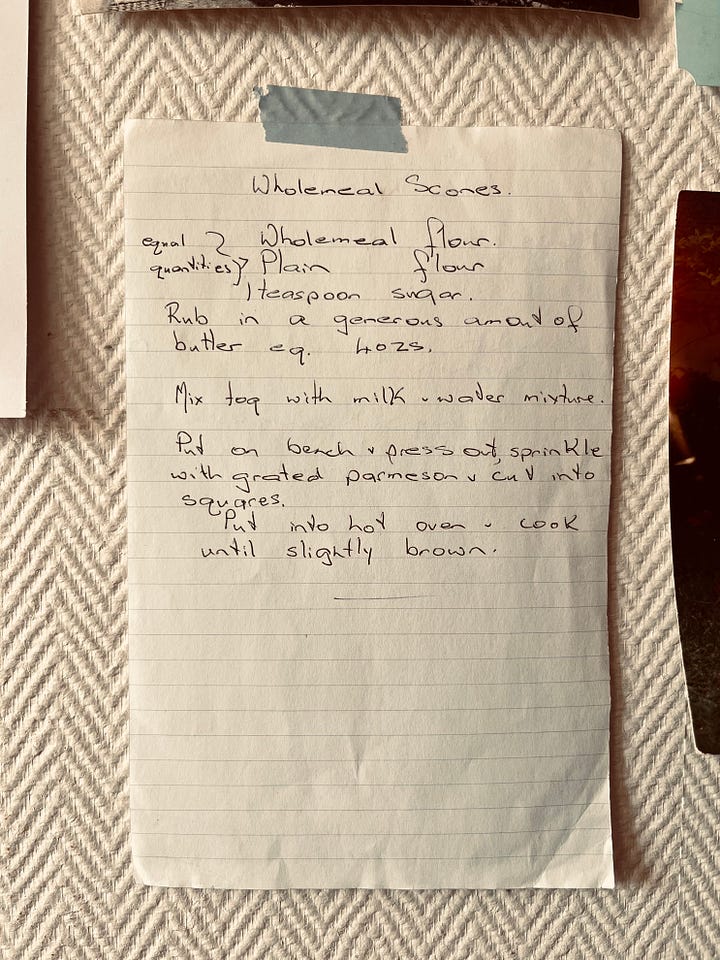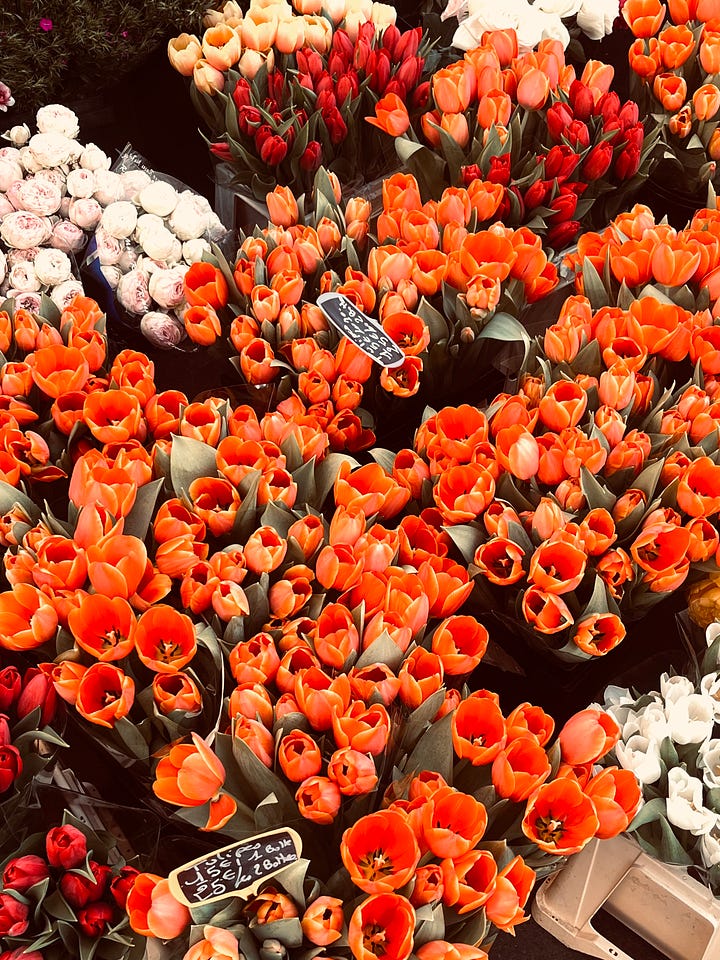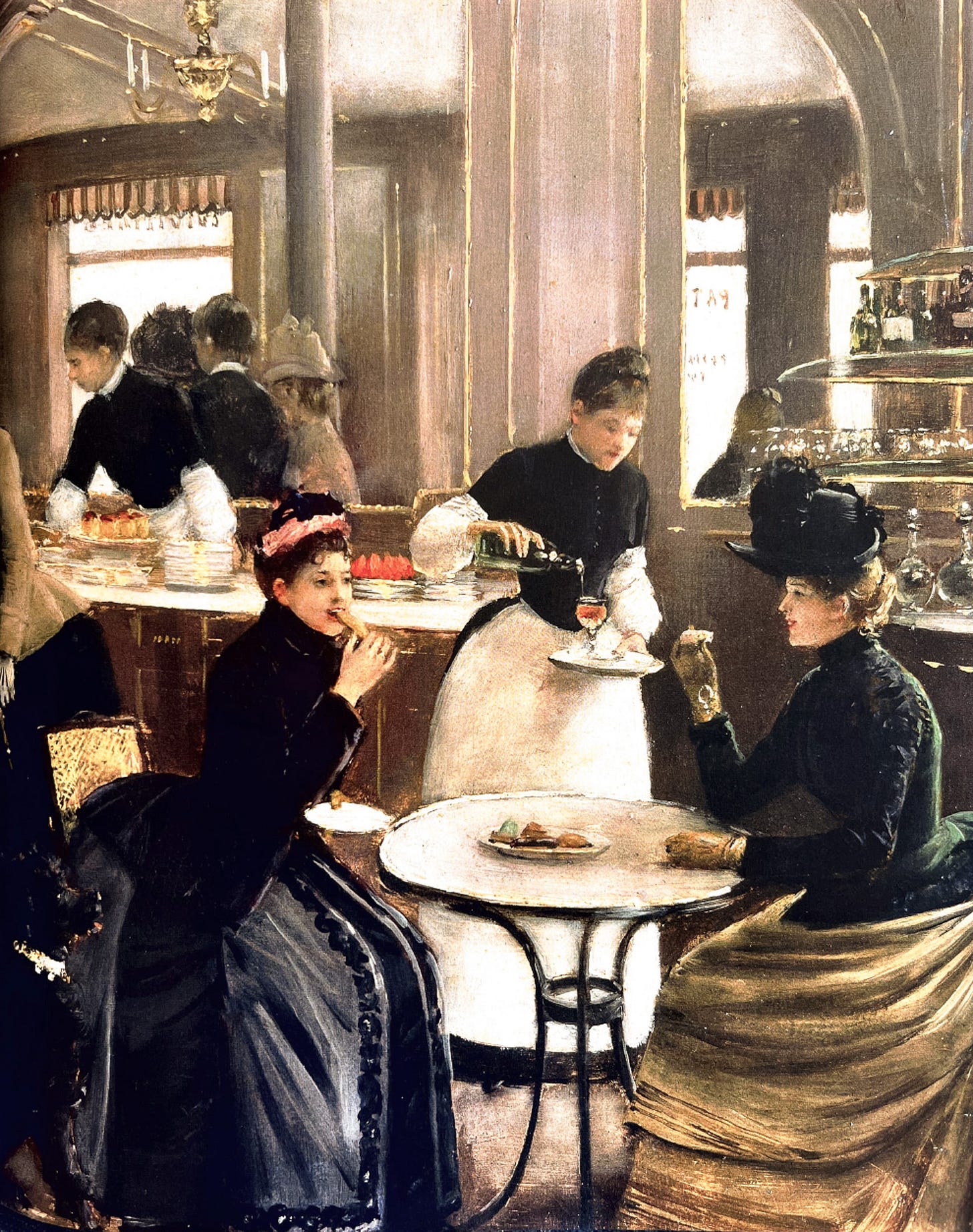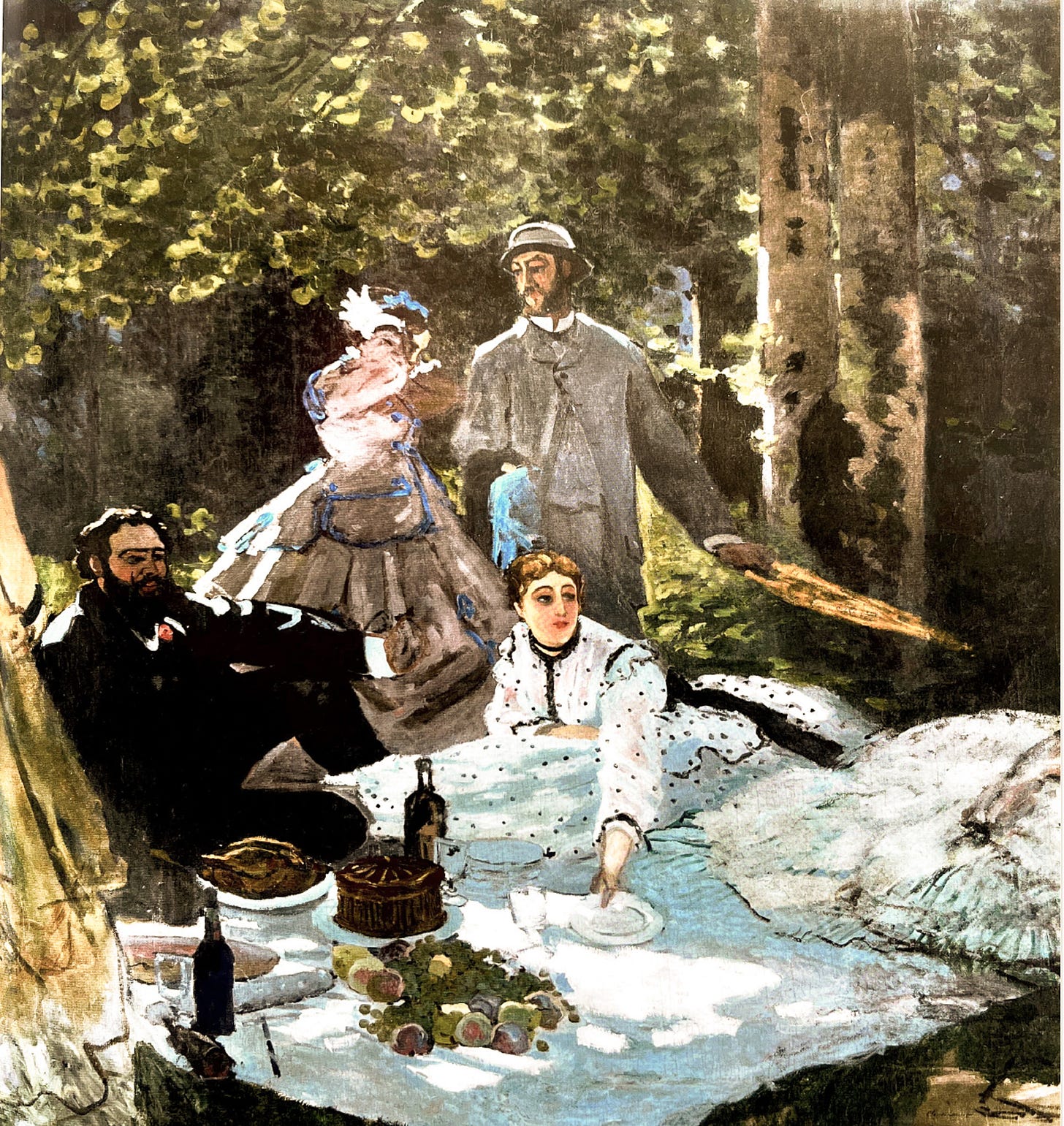A rainy Friday afternoon in Musée d’Orsay, looking up at the works of Édouard Manet, Édouard Vuillard and Toulouse Lautrec; wandering through rooms of Gauguin, Van Gogh and Monet. You’ll link arms as you shelter from the rain under her umbrella, wandering back streets to find a quiet spot for a little goûter. A slice of apple tart and two pots of black tea sit between the two of you talking about the men in your lives. She’ll point to the copy of Annie Erneaux’s Simple Passion poking up out of your jacket pocket as you get up to leave, laughing at how far from ‘simple’ passion can be. Dinner will be a crêpe each; jambon blanc from Brittany, egg, Comté and a small square of butter to melt into the hot buckwheat crêpe, or vegetables du moment with chèvre frais, Piment d’Espelette and an egg. A walk home crosses over the Seine under the now-clear, inky blue night sky.
Spring rain, spring sunshine. Saturday markets in the 12th under clear blue skies will be jolly, will be lively. Artichokes, gariguette strawberries, leeks. Big fat green olives and green tapenade, dried baby figs and dried spicy ginger. Chèvre frais and tomme de brebis from the Basque. A mackerel filet to make rillette and a bag of sprightly greens to make a simple salad. Green asparagus, white asparagus.
He’ll meet you at the oyster stand for a dozen between the two of you, and a glass of white wine each. A small bowl of bread cut into squares and a small bowl of mignonette. You’ll take turns fishing out the pieces of pickled shallot sitting in the bottom of the bowl and spoon them onto each oyster before pouring them down your throats.
A Sunday lunch. You’ll shred the the mackerel filet into a silver bowl and spoon in two large spoonfuls of créme fraîche. Sliced chives, chopped dill. Lemon zest, heavy with freshly ground black pepper, a pinch of salt. You’ll whip it with a fork as he pulls out the jar of cornichons and places it on the bench next to you, “what do you think?”, he’ll ask. Chopped finely, in they go. More whipping, a taste each. Served with fresh bread and salted butter, two different cheeses and a simple green salad for a simple Sunday lunch.
Plans will be made to pack a picnic of chicken sandwiches and pastis to take to Père Lachaise to wander through the graves of the greats. He’ll research the graves, you’ll think about the details of the chicken sandwich. Probably mayonnaise, dill, cornichon and perhaps walnuts with the shredded chicken; cold crunchy lettuce, butter and a baguette. I wonder whether Oscar Wilde, Colette, Gertrude Stein, Proust or Jim Morrison would have enjoyed a chicken sandwich. Certainly they would have enjoyed a pastis. I wonder whether it’s odd, or ungracious to eat and drink amongst graves.
Freshly squeezed blood orange juice; clean white sheets; a crisp, cotton white night gown; a small, dainty white cup full of hot black coffee.
The windows are wide open for the first time since last year, since before the winter. You’ll sit on the oil heater whose days are nearly done for another season. He’ll stand next to you and light a cigarette. The sun will touch your bare arms and your clean face that you just splashed with cold water. You’ll both be in old, soft white t-shirts and old, loved jeans. You’ll look down from that fourth floor window seat at a women with long auburn hair and porcelain skin wearing a silk dress in olive green, catching glimpses of her through branches of thick, white blossoms. He’ll ask if you’d wear a dress like that, only knowing one another in their winter forms, their winter ways, their winter clothes.
A strawberry will sit on a candle stick, in place of a candle. It’ll be there for a few days, struck by streams of sunshine in the late afternoon. It feels to represent the glow, the spark of spring, sitting there in place of the glowing candles that softened and warmed through winter.
You’ll sit by the canal with what feels like the rest of Paris, practically sitting on each other to get a spot in the sun — everyone well and truly reminded that yes, other humans do live in this city, they’ve just all been hibernating under grey skies these past months. You’ll read Jeremy Lee’s words on chard — romance — and flip through Danielle Alvarez’s recipes — more romance. Danielle’s Turkish meatballs with yoghurt and rice pilaf for dinner.


You’ll tape his handwritten grocery list to your wall. And you’ll tape your grandmother’s savoury, wholemeal scone recipe to your wall. You’ll look at their handwriting daily, think of them and smile.


You’ll read things aloud to each other that stir — sentences you’ve read, lyrics you’ve heard …
“I sometimes think of this condition as the charisma of food, its capacity to be everything. It is identity, and culture, and history. It is science and nature, and botany. It is the earth. It is our family, our philosophy, our past. It is the most important matter in our lives. It is more than its ingredients. It is transcendent. But it is also just dinner. It means nothing. It is serious, and not.”
“Perfection is less interesting. For instance, a page with a poem on it is less attractive than a page with a poem on it and some tea stains. Because the tea stains add a bit of history.”
“For he’s touched your perfect body with his mind.”
Wicked Game by Chris Isaak will play from the kitchen as you lay in bed together under flickering candle light. The song now forever linked to that moment.
An omelette for ‘breakfast’ at 1pm. A plate of blood oranges on the table. A dried rose on the bookshelf. A dear friend’s handwriting listing three different cheeses that we once served at breakfast in Provence. The shadows of the iron balcony cast up against the white wall as the sun goes down an hour later than yesterday after having turned the clocks forward for the summer.
The line between the ordinary and the extraordinary.
A piece sparked from Virginia Woolf’s words:


Although, human connection is no ordinary thing — friendship or romance. And in this world that we’re all living in, increasingly the ordinary is extraordinary — having a safe and sunny window to sit in, having access to well-grown food, having freedom; living quietly and simply in a world that’s chaotic and cruel.
The paintings here are from a book that I’ve been spending a lot of time with lately: L’Art et La Table by Patrick Rambourg. It’s an anthology showing the representation of food and the table in art, going back to before the Middle Ages. The book explores the relationship between artistic practices and food practices, with a focus on Western table culture. It’s a book full of beauty.










Beautiul, thank you.
Art/food/life - living!
Love this! Reminds me of the chilled oysters and cucumber mignonette recipe I adapted from hit NYC restaurant Via Carota for easy home cooking!
check it out:
https://thesecretingredient.substack.com/p/get-via-carota-recipe-chilled-oysters-with-cucumber-mignonette